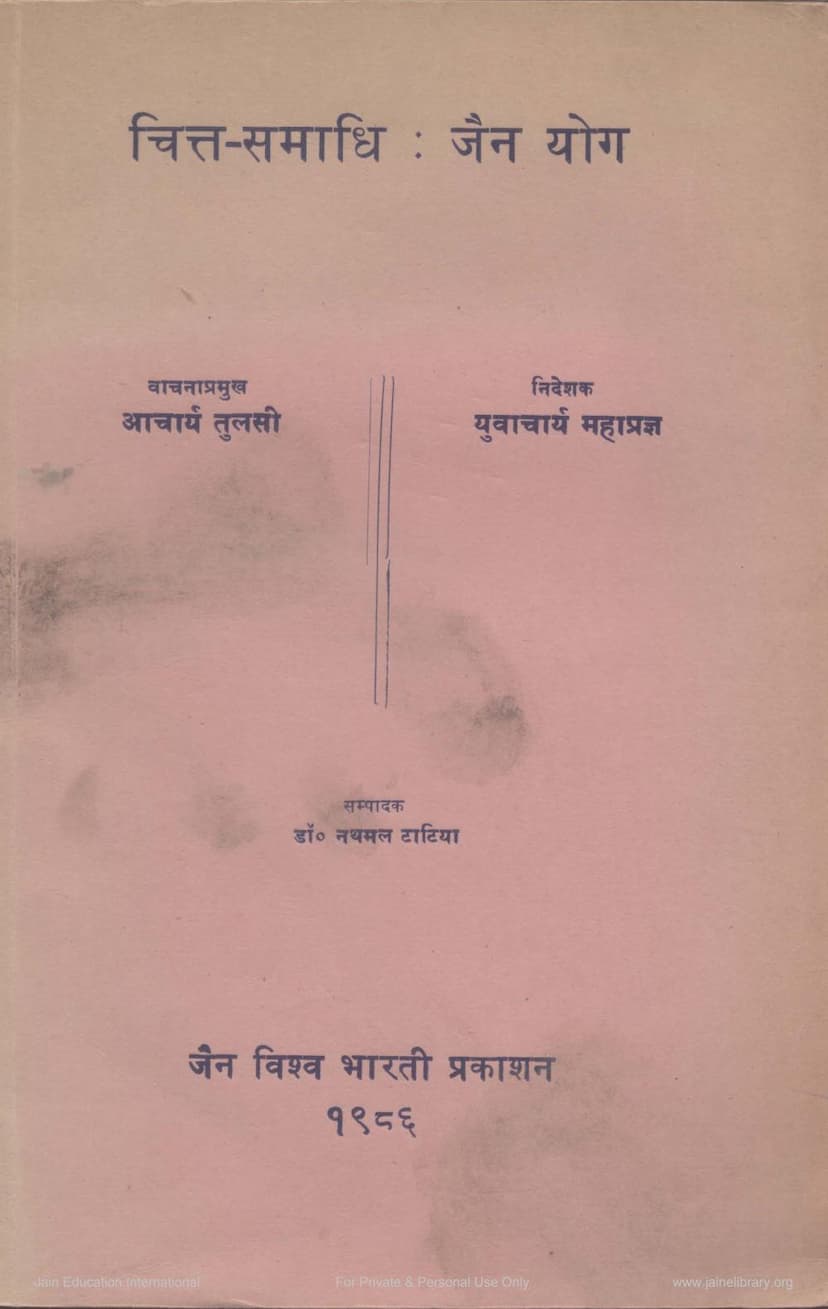Chitta Samadhi Jain Yog
Added to library: September 1, 2025

Summary
This document is a summary in English of the Jain text "Chitta Samadhi: Jain Yog" by Acharya Tulsi and Acharya Mahapragna, published by Jain Vishva Bharati in 1986. The book serves as a postgraduate curriculum for Jain Yoga, compiling scattered yogic materials from Jain scriptures.
Here's a breakdown of its key aspects based on the provided pages:
Core Purpose: The book's primary aim is to guide practitioners towards "Chitta Samadhi" (mental concentration/equanimity) through the principles and practices of Jain Yoga. It acknowledges that much of this wisdom was lost over time, with only a few texts like 'Samadhi Shatak' and 'Kayotsarg Shatak' surviving, and scattered seeds of meditation techniques found in Agam Sutras. This curriculum is designed to be a comprehensive resource for those seeking to study Jain Yoga in depth.
Content and Structure: The book is structured as a compilation of texts from various Jain scriptures, along with insightful commentary. The key sources and topics include:
-
Acharanga Sutra (Aayaro): This forms a significant part of the curriculum, covering topics such as:
- Preksha Meditation
- Samattva Darshan (Equanimity)
- Prasad and Aprasad (Negligence and Diligence)
- Kama and Arth (Desire and Purpose)
- Brahmacharya (Celibacy)
- Aparigraha (Non-possession)
- Satya (Truth)
- Sukha-Dukha (Happiness and Sorrow)
- Ahinsa (Non-violence)
- Asrava, Samvara, Karmavada (Flows, Restraint, Karma Theory)
- Body, the will to live, Muni (ascetic) life, food
- Taste aversion, obedience,acharya (preceptor), anupreksha (contemplation)
- Dhutavada (ascetic practices), Dhyanasana (meditative postures)
- Solitary and group sadhana (spiritual practice)
- Samadhi Marana (meditative death)
- Extensive notes (63 in total) are provided to clarify complex subjects.
-
Sthananga Sutra (Sthanam): This text, described as an encyclopedia of Jain philosophy, is utilized to cover aspects of mental equanimity:
- The cycle of worldly existence, passions (kashaya) and their origins.
- Obstacles to mental equanimity (e.g., delusion, negligence, ignorance, attachment, desires).
- The path to mental equanimity (e.g., worship, discipline, perception, knowledge, body, speech, mind, cessation, happiness, strength).
- Discussions on transcendental consciousness, asceticism, and supra-sensory knowledge.
- Parts are collected under 10 titles related to mental equanimity and its impediments and paths.
-
Uttaradhyayana Sutra (Uttarajjhayani): Four chapters are included, offering profound insights into spiritual practice, including "Sammatt-Parakrame" (Effort for Right Faith), considered a guiding path in Jain spiritual progress.
-
Perishishta (Appendix): This section includes texts like Moksha Pahuda, Samayasar (First Chapter), Manonushasan, and Hathayogapradipika (the entire text).
-
Suyagada, Bhagavati, Prashnavyakaran, and Dashashrutaskandha: Texts from these scriptures are also compiled, with accompanying notes for some.
Key Themes and Concepts: The book delves into various aspects of yogic practice and their connection to mental equanimity within the Jain framework:
- Chitta Samadhi: The central theme, achieved through various Jain yoga methods.
- Vitaraga-dasha: The state of being free from attachment and aversion, where the mind remains absorbed.
- The Importance of Scripture: The collection and study of scattered scriptural knowledge are highlighted to rebuild the understanding of Jain Yoga.
- Discipline and Awareness: Practices like "Pratikraman" (confession/reflection), "Pratisamlinata" (withdrawal of senses), and "Samayik" (equanimity) are implicitly or explicitly discussed as means to achieve mental control.
- Inner Transformation: Emphasis is placed on understanding the internal states of the mind, overcoming obstacles like attachment, desire, and ignorance.
- The Role of the Guru: The importance of guidance from a spiritual teacher is implied, especially in understanding the subtle nuances of yogic practices.
- Integration of Practice and Philosophy: The book aims to provide both the theoretical and practical aspects of Jain spiritual discipline.
Methodology: The curriculum is designed for postgraduate study, indicating a deep and analytical approach to the subject. The compilation of texts from various sources allows for a multi-faceted understanding of Jain yogic traditions. The inclusion of detailed notes signifies an effort to make complex philosophical and practical concepts accessible to students.
Overall Significance: "Chitta Samadhi: Jain Yog" represents a significant effort to systematically present the rich but often fragmented teachings of Jain Yoga. It aims to provide a renewed perspective and a solid foundation for scholars and practitioners interested in this profound path to mental peace and self-realization within the Jain tradition.